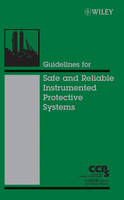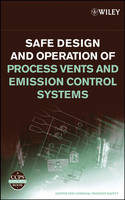Guidelines for Safe and Reliable Instrumented Protective Systems
 -15%
portes grátis
-15%
portes grátis
Guidelines for Safe and Reliable Instrumented Protective Systems
CCPS (Center for Chemical Process Safety)
John Wiley & Sons Inc
05/2007
430
Dura
Inglês
9780471979401
15 a 20 dias
734
Descrição não disponível.
Acknowledgements. Preface.
List of Figures.
List of Tables.
INTRODUCTION.
1.1 Purpose.
1.2 Target Audience.
Book Road Map.
1.4 Management Commitment.
PLANNING.
2.1 Protective Management System Lifecycle.
2.2 Why It Makes Good Business Sense.
2.3 Documentation.
2.4 Good Engineering Practices.
2.5 Key Management System Elements.
2.6 Special Topics.
RISK ASSESSMENT.
3.1 Intended Audience.
3.2 Input Information.
3.3 Basic Work Process.
3.4 Output Documentation.
3.5 Key Management System Elements.
3.6 Special Topics.
DESIGN.
4.1 Intended Audience.
4.2 Input Information.
4.3 Basic Work Process.
4.4 Output Documentation.
4.5 Process Requirements.
4.6 I&E Requirements.
4.7 Functional Assessment.
4.8 Key Management System Elements.
4.9 Special Topics.
ENGINEERING, INSTALLATION, COMMISSIONING AND VALIDATION.
5.1 Intended Audience.
5.2 Input Information.
5.3 Basic Work Projects.
5.4 Output Documentation.
5.5 Hardware.
5.6 Software.
5.7 Factory Acceptance Test.
5.8 Installation Plans.
5.9 Commissioning Plans.
5.10 Verify Operator and External Interfaces.
5.11 Validation.
5.12 Management of Change.
OPERATIONAL AND MECHANICAL INTEGRITY.
6.1 Intended Audience.
6.2 Input Information.
6.3 Basic Work Process.
6.4 Output Documentation.
6.5 Operating Procedures.
6.6 Bypass management Procedure.
6.7 Maintenance Procedures.
6.8 Training.
6.9 Managing Changes.
6.10 Monitoring performance.
CONTINOUS IMPROVEMENT.
7.1 Intended Audience.
7.2 Input Information.
7.3 Basic Work Process.
7.4 Output Documentation.
7.5 Determining Path Forward.
DEFINITIONS.
PROTECTION LAYERS.
B.1 Inherently Safer Design.
B.2 Control.
B.3 Supervisory.
B.4 Preventive.
B.5 Mitigative.
B.6 Barriers.
B.7 Limitation.
B.8 Response.
CORE ATTRIBUTES.
C.1 Independence.
C.2 Functionality.
C.3 Integrity.
C.4 Reliability.
C.5 Auditability.
C.6 Access Security.
C.7 Management of Change.
UNDERSTANDING FAILURE.
D.1 Caution-It's A Benchmark.
D.2 A "Bathtub"; Viewpoint.
D.3 Failure Types.
D.4 Failure Classification.
D.5 IPF Performance metrics.
D.6 Spurious Trip Rate.
D.7 Example Application.
PROCESS EQUIPMENT RELIABILITY DATABASE.
USER APPROVED EQUIPMENT AND PRACTICES.
F.1 User Approved.
F.2 Evolution of Plant Automation.
F.3 Logic Solver Considerations.
F.4 Field Device Considerations.
F.5 Utilities.
F.6 Wiring Practices.
F.7 Communications and Interconnectivity.
F.8 Prescriptive Design.
References.
Acronyms and Abbreviations.
Index.
List of Figures.
List of Tables.
INTRODUCTION.
1.1 Purpose.
1.2 Target Audience.
Book Road Map.
1.4 Management Commitment.
PLANNING.
2.1 Protective Management System Lifecycle.
2.2 Why It Makes Good Business Sense.
2.3 Documentation.
2.4 Good Engineering Practices.
2.5 Key Management System Elements.
2.6 Special Topics.
RISK ASSESSMENT.
3.1 Intended Audience.
3.2 Input Information.
3.3 Basic Work Process.
3.4 Output Documentation.
3.5 Key Management System Elements.
3.6 Special Topics.
DESIGN.
4.1 Intended Audience.
4.2 Input Information.
4.3 Basic Work Process.
4.4 Output Documentation.
4.5 Process Requirements.
4.6 I&E Requirements.
4.7 Functional Assessment.
4.8 Key Management System Elements.
4.9 Special Topics.
ENGINEERING, INSTALLATION, COMMISSIONING AND VALIDATION.
5.1 Intended Audience.
5.2 Input Information.
5.3 Basic Work Projects.
5.4 Output Documentation.
5.5 Hardware.
5.6 Software.
5.7 Factory Acceptance Test.
5.8 Installation Plans.
5.9 Commissioning Plans.
5.10 Verify Operator and External Interfaces.
5.11 Validation.
5.12 Management of Change.
OPERATIONAL AND MECHANICAL INTEGRITY.
6.1 Intended Audience.
6.2 Input Information.
6.3 Basic Work Process.
6.4 Output Documentation.
6.5 Operating Procedures.
6.6 Bypass management Procedure.
6.7 Maintenance Procedures.
6.8 Training.
6.9 Managing Changes.
6.10 Monitoring performance.
CONTINOUS IMPROVEMENT.
7.1 Intended Audience.
7.2 Input Information.
7.3 Basic Work Process.
7.4 Output Documentation.
7.5 Determining Path Forward.
DEFINITIONS.
PROTECTION LAYERS.
B.1 Inherently Safer Design.
B.2 Control.
B.3 Supervisory.
B.4 Preventive.
B.5 Mitigative.
B.6 Barriers.
B.7 Limitation.
B.8 Response.
CORE ATTRIBUTES.
C.1 Independence.
C.2 Functionality.
C.3 Integrity.
C.4 Reliability.
C.5 Auditability.
C.6 Access Security.
C.7 Management of Change.
UNDERSTANDING FAILURE.
D.1 Caution-It's A Benchmark.
D.2 A "Bathtub"; Viewpoint.
D.3 Failure Types.
D.4 Failure Classification.
D.5 IPF Performance metrics.
D.6 Spurious Trip Rate.
D.7 Example Application.
PROCESS EQUIPMENT RELIABILITY DATABASE.
USER APPROVED EQUIPMENT AND PRACTICES.
F.1 User Approved.
F.2 Evolution of Plant Automation.
F.3 Logic Solver Considerations.
F.4 Field Device Considerations.
F.5 Utilities.
F.6 Wiring Practices.
F.7 Communications and Interconnectivity.
F.8 Prescriptive Design.
References.
Acronyms and Abbreviations.
Index.
Este título pertence ao(s) assunto(s) indicados(s). Para ver outros títulos clique no assunto desejado.
list; business; good; sense; engineering; information; requirements; classification; reliability; automation; evolution; projects life; protective; ips; instrumented; management; cycle; book; decisionmaking; systems; processes; safe; work
Acknowledgements. Preface.
List of Figures.
List of Tables.
INTRODUCTION.
1.1 Purpose.
1.2 Target Audience.
Book Road Map.
1.4 Management Commitment.
PLANNING.
2.1 Protective Management System Lifecycle.
2.2 Why It Makes Good Business Sense.
2.3 Documentation.
2.4 Good Engineering Practices.
2.5 Key Management System Elements.
2.6 Special Topics.
RISK ASSESSMENT.
3.1 Intended Audience.
3.2 Input Information.
3.3 Basic Work Process.
3.4 Output Documentation.
3.5 Key Management System Elements.
3.6 Special Topics.
DESIGN.
4.1 Intended Audience.
4.2 Input Information.
4.3 Basic Work Process.
4.4 Output Documentation.
4.5 Process Requirements.
4.6 I&E Requirements.
4.7 Functional Assessment.
4.8 Key Management System Elements.
4.9 Special Topics.
ENGINEERING, INSTALLATION, COMMISSIONING AND VALIDATION.
5.1 Intended Audience.
5.2 Input Information.
5.3 Basic Work Projects.
5.4 Output Documentation.
5.5 Hardware.
5.6 Software.
5.7 Factory Acceptance Test.
5.8 Installation Plans.
5.9 Commissioning Plans.
5.10 Verify Operator and External Interfaces.
5.11 Validation.
5.12 Management of Change.
OPERATIONAL AND MECHANICAL INTEGRITY.
6.1 Intended Audience.
6.2 Input Information.
6.3 Basic Work Process.
6.4 Output Documentation.
6.5 Operating Procedures.
6.6 Bypass management Procedure.
6.7 Maintenance Procedures.
6.8 Training.
6.9 Managing Changes.
6.10 Monitoring performance.
CONTINOUS IMPROVEMENT.
7.1 Intended Audience.
7.2 Input Information.
7.3 Basic Work Process.
7.4 Output Documentation.
7.5 Determining Path Forward.
DEFINITIONS.
PROTECTION LAYERS.
B.1 Inherently Safer Design.
B.2 Control.
B.3 Supervisory.
B.4 Preventive.
B.5 Mitigative.
B.6 Barriers.
B.7 Limitation.
B.8 Response.
CORE ATTRIBUTES.
C.1 Independence.
C.2 Functionality.
C.3 Integrity.
C.4 Reliability.
C.5 Auditability.
C.6 Access Security.
C.7 Management of Change.
UNDERSTANDING FAILURE.
D.1 Caution-It's A Benchmark.
D.2 A "Bathtub"; Viewpoint.
D.3 Failure Types.
D.4 Failure Classification.
D.5 IPF Performance metrics.
D.6 Spurious Trip Rate.
D.7 Example Application.
PROCESS EQUIPMENT RELIABILITY DATABASE.
USER APPROVED EQUIPMENT AND PRACTICES.
F.1 User Approved.
F.2 Evolution of Plant Automation.
F.3 Logic Solver Considerations.
F.4 Field Device Considerations.
F.5 Utilities.
F.6 Wiring Practices.
F.7 Communications and Interconnectivity.
F.8 Prescriptive Design.
References.
Acronyms and Abbreviations.
Index.
List of Figures.
List of Tables.
INTRODUCTION.
1.1 Purpose.
1.2 Target Audience.
Book Road Map.
1.4 Management Commitment.
PLANNING.
2.1 Protective Management System Lifecycle.
2.2 Why It Makes Good Business Sense.
2.3 Documentation.
2.4 Good Engineering Practices.
2.5 Key Management System Elements.
2.6 Special Topics.
RISK ASSESSMENT.
3.1 Intended Audience.
3.2 Input Information.
3.3 Basic Work Process.
3.4 Output Documentation.
3.5 Key Management System Elements.
3.6 Special Topics.
DESIGN.
4.1 Intended Audience.
4.2 Input Information.
4.3 Basic Work Process.
4.4 Output Documentation.
4.5 Process Requirements.
4.6 I&E Requirements.
4.7 Functional Assessment.
4.8 Key Management System Elements.
4.9 Special Topics.
ENGINEERING, INSTALLATION, COMMISSIONING AND VALIDATION.
5.1 Intended Audience.
5.2 Input Information.
5.3 Basic Work Projects.
5.4 Output Documentation.
5.5 Hardware.
5.6 Software.
5.7 Factory Acceptance Test.
5.8 Installation Plans.
5.9 Commissioning Plans.
5.10 Verify Operator and External Interfaces.
5.11 Validation.
5.12 Management of Change.
OPERATIONAL AND MECHANICAL INTEGRITY.
6.1 Intended Audience.
6.2 Input Information.
6.3 Basic Work Process.
6.4 Output Documentation.
6.5 Operating Procedures.
6.6 Bypass management Procedure.
6.7 Maintenance Procedures.
6.8 Training.
6.9 Managing Changes.
6.10 Monitoring performance.
CONTINOUS IMPROVEMENT.
7.1 Intended Audience.
7.2 Input Information.
7.3 Basic Work Process.
7.4 Output Documentation.
7.5 Determining Path Forward.
DEFINITIONS.
PROTECTION LAYERS.
B.1 Inherently Safer Design.
B.2 Control.
B.3 Supervisory.
B.4 Preventive.
B.5 Mitigative.
B.6 Barriers.
B.7 Limitation.
B.8 Response.
CORE ATTRIBUTES.
C.1 Independence.
C.2 Functionality.
C.3 Integrity.
C.4 Reliability.
C.5 Auditability.
C.6 Access Security.
C.7 Management of Change.
UNDERSTANDING FAILURE.
D.1 Caution-It's A Benchmark.
D.2 A "Bathtub"; Viewpoint.
D.3 Failure Types.
D.4 Failure Classification.
D.5 IPF Performance metrics.
D.6 Spurious Trip Rate.
D.7 Example Application.
PROCESS EQUIPMENT RELIABILITY DATABASE.
USER APPROVED EQUIPMENT AND PRACTICES.
F.1 User Approved.
F.2 Evolution of Plant Automation.
F.3 Logic Solver Considerations.
F.4 Field Device Considerations.
F.5 Utilities.
F.6 Wiring Practices.
F.7 Communications and Interconnectivity.
F.8 Prescriptive Design.
References.
Acronyms and Abbreviations.
Index.
Este título pertence ao(s) assunto(s) indicados(s). Para ver outros títulos clique no assunto desejado.




